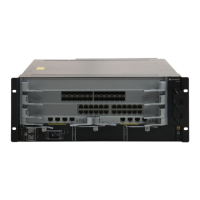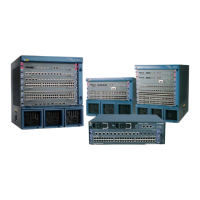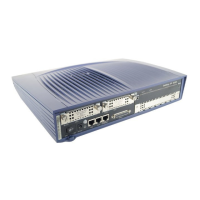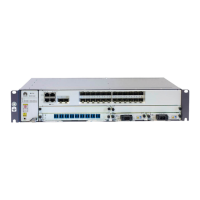The HVRP application involves the following operations:
1. Registering VLANs
l Each Switch periodically sends the local VLAN information through the HVRP root
interface.
l Each Switch forwards the received local VLAN information through the HVRP root
interface. In addition, each Switch registers local VLANs on the HVRP designated
interface according to the local VLAN information received from the HVRP designated
interface.
l VLAN registration and aging can be performed only on HVRP designated interfaces.
l A VLAN can be registered on an interface only after the interface is added to the VLAN
statically. For example, if an HVRP designated interface does not belong to VLAN 999,
VLAN 999 cannot be registered on the HVRP designated interface even if the interface
receives an HVRP packet with local VLAN 999.
2. Aging VLANs
If an HVRP designated interface does not receive any VLAN registration packet within the
aging time, the VLANs on the HVRP designated interface are aged.
By default, only local VLANs are aged. You can configure the S7700 to age all the VLANs.
3. Sending and maintaining local VLAN information
The HVRP root interface periodically sends local VLAN registration packets according to
the VLAN registration timer.
When the role of a local VLAN changes, for example, the VLAN is not a local VLAN any
more because the configuration is changed, the Switch sends the local VLAN information
through the HVRP root interface immediately.
4. Re-registering VLANs when the status of an HVRP interface changes to Up or Down
When the status of an HVRP interface changes to Up or Down, the aged VLANs may
interrupt forwarding of Layer 2 packets on the entire network. Therefore, when a Switch
detects that the status of an HVRP interface changes, the Switch immediately sends a restore
packet to notify all the other Switches on the network. Then the Switches re-register the
aged VLANs on the original interfaces.
5. Re-registering VLANs when the STP role of an HVRP interface changes
When the STP role of an HVRP interface changes, the aged VLANs on this interface are
re-registered on the interface.
6. Counting interfaces in a VLAN
l A Switch updates the number of interfaces in a VLAN every time an interface is added
to or deleted from the VLAN, the VLAN is registered, or the VLAN is aged.
l A trunk interface is counted as one interface.
7. MAC address learning mode in a VLAN
l When a VLAN contains more than two non-aged interfaces, the interfaces learn MAC
addresses.
l When a VLAN contains two or less than two non-aged interfaces, the interfaces do not
learn MAC addresses. In addition, the dynamic MAC addresses learned before are
deleted.
Quidway S7700 Smart Routing Switch
Configuration Guide - Ethernet 12 HVRP Configuration
Issue 01 (2011-07-15) Huawei Proprietary and Confidential
Copyright © Huawei Technologies Co., Ltd.
613

